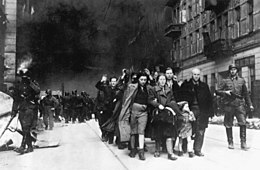隔都起义
第二次世界大战期间的隔都起义(又称犹太人区起义)是1941年至1943年期间一系列反抗纳粹德国的武装起义的总称,发生在纳粹德国在欧洲占领区中建立不久的诸多隔都(Ghetto)中。随着1939年9月德苏入侵波兰,波兰犹太人从一开始就被纳粹当局针对。德国用了几个月的时间在波兰占领区划分了数百个隔都,强迫犹太人在这些区域中生活。建立隔都是德国将犹太人从公共生活中移除的官方计划的一部分,旨在从经济上剥削犹太人。[1]过高的羁押人数、糟糕的卫生条件以及食物匮乏共同导致了隔都居民的高死亡率。[2]在大多数城市中,犹太地下抵抗运动立即开始发展,但隔都化管理极大限制了抵抗运动的可用资源。[3]
| 隔都起义 | |
|---|---|
 | |
| 别名 | 犹太区起义 |
| 地点 | 纳粹占领区 |
| 日期 | 1941–1943年,第二次世界大战期间 |
| 事件类型 | 武装起义 |
隔都抵抗战士在犹太人大屠杀最致命的阶段——纳粹于1942年发起的“莱茵哈德行动”时期武装斗争,反抗纳粹将关押的所有男女老幼遣送至灭绝营实施大规模灭杀的“最终解决方案”。[3]
历史
编辑波兰犹太人的武装抵抗在1939年时的波兰-苏联边境两侧100多个地点爆发过,绝大多数发生在波兰东部。[4][5]一些起义是有组织的大规模起义,还有一些是较小规模的自发抵抗。犹太人大屠杀期间最为著名、规模最大的犹太起义是1943年4月19日至5月16日的华沙隔都起义[6]以及同年8月的比亚韦斯托克隔都起义。在华沙隔都起义期间,56,065名犹太人被当场击毙,或是被抓捕后由大屠杀列车押送至灭绝营;华沙隔都被夷为平地。[7][8]比亚韦斯托克隔都中的1万人被押上大屠杀列车、2000人被就地处决后, 隔都地下武装组织了一场大规模起义,导致该区被封锁长达一个月。[9]有一些隔都的抵抗运动导致整个隔都被焚毁,譬如位于现在乌克兰境内的科洛梅亚隔都。[10]在另一些起义后(譬如米佐什隔都起义),纳粹大规模射杀妇女儿童以报复犹太人起义。[11][12]
犹太人大屠杀期间主要的隔都起义
编辑犹太人大屠杀期间有5座大城市、45个主要城镇、5座主要集中营/灭绝营、以及至少18处劳改营发生了犹太起义。[13]一些重要的隔都起义包括:[14]
- 1942年9月3日拉赫瓦隔都起义
- 1942年10月14日米佐什隔都起义
- 1943年1月10日明斯克马佐维耶斯基隔都囚犯暴动
- 1943年4月19日-5月16日华沙隔都起义,由犹太战斗组织与犹太军事联盟组织的大规模起义
- 1943年6月25日-30日琴斯托霍瓦隔都起义
- 1943年8月3日本津隔都起义,又称本津—索斯诺维茨隔都起义
- 1943年8月16日-17日比亚韦斯托克隔都起义,由反法西斯军事组织发起的起义
一些其他的隔都在最终被纳粹消灭时也遇到了不同程度的武装抵抗:
参见
编辑注解
编辑- ^ Wolf Gruner, Jewish Forced Labor Under the Nazis: Economic Needs and Racial Aims, 1938-1944, Cambridge University Press: 249–250, 2006 [2019-01-19], ISBN 0521838754, (原始内容存档于2017-07-30),
By the end of 1940, the forced-labor program in the General Government had registered over 700,000 Jewish men and women who were working for the German economy in ghetto businesses and as labor for projects outside the ghetto; there would be more.
- ^ Marek Edelman. The Ghetto Fights. The Warsaw Ghetto: The 45th Anniversary of the Uprising. Literature of the Holocaust, at the University of Pennsylvania. [2013-10-02]. (原始内容存档于2009-11-25).
- ^ 3.0 3.1 Resistance in Ghettos. Jewish Uprisings in Ghettos and Camps, 1941–1944. Holocaust Encyclopedia. 2013-06-10 [2014-01-09]. (原始内容存档于2012-05-14).
- ^ Shmuel Krakowski, Armed Resistance, YIVO, 2010 [2019-01-19], (原始内容存档于2011-06-02)
- ^ Jewish Resistance. United States Holocaust Memorial Museum. 2011 [2014-01-09]. (原始内容存档于2012-01-26) –通过Internet Archive.
- ^ April–May 1943, Warsaw Ghetto Uprising. Timeline of Events. United States Holocaust Memorial Museum. 2013 [2014-01-09]. (原始内容存档于2014-01-09).
- ^ World War II: Warsaw Ghetto Uprising. Originally published by World War II magazine. 2006-06-12 [2014-09-04]. (原始内容存档于2014-11-06).
See also: Stroop Report for supplementary data.
- ^ Marcin Wilczek. A Somber Anniversary. ZSSEDU. 2011-04-19 [2014-09-04]. (原始内容存档于2016-03-15).
- ^ Sara Bender. The Jews of Bialystok During World War II and the Holocaust. The End of the Ghetto (UPNE). 2008: 253–263 [2019-01-19]. ISBN 1584657294. (原始内容存档于2018-11-05) –通过Google Books preview.
- ^ Warsaw Ghetto Uprising. Holocaust Encyclopedia. Holocaust Memorial Museum, Washington DC. 2012 [2014-01-09]. (原始内容存档于2012-10-28).
- ^ Eve Nussbaum Soumerai, Carol D. Schulz, Daily Life During the Holocaust (页面存档备份,存于互联网档案馆), p. 124. ISBN 0313353093.
- ^ Photographs of the Mizocz shootings (页面存档备份,存于互联网档案馆) in the USHMM collection (No. 17876, 17877, (页面存档备份,存于互联网档案馆) 17878 (页面存档备份,存于互联网档案馆), 17879). Retrieved 26 October 2015.
- ^ United States Holocaust Memorial Museum, Resistance during the Holocaust (PDF), The Miles Lerman Center for the Study of Jewish Resistance, p. 6 of 56 in current document, [2019-01-19], (原始内容存档 (PDF)于2017-08-29).
- ^ Map of the Jewish uprisings in World War II (PDF file, direct download 169 KB). Yad Vashem. 2013 [2014-01-09]. (原始内容存档 (PDF)于2013-07-18).
参见
编辑- 以色列犹太大屠杀纪念馆网站上关于犹太武装抵抗运动和起义的记述,2014年1月9日查询
- JTA. 58,000 Jews Executed by Nazis in Kolomyja; Thousands Burned Alive. Archive. Jewish Telegraphic Agency. 1943-03-07 [2019-01-19]. (原始内容存档于2021-03-28).
数百名犹太人仍留在隔都内的藏身处。为了确保消灭这些人,盖世太保的主管下令将隔都焚烧殆尽,从而完成对克罗米亚“彻底的犹太人清洗”。(A few hundred Jews remained in their ghetto hideouts. In order to make certain that not a single one of them would remain alive, the chief of the Gestapo ordered the ghetto burnt down to the ground, thus finishing the process of making Kolomyja “completely judenrein.”)
